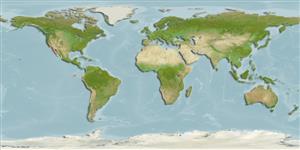>
Blenniiformes (Blennies) >
Blenniidae (Combtooth blennies) > Salariinae
Etymology: Hypsoblennius: Greek, hypsi = high + Greek, blennios = mucus (Ref. 45335).
More on author: Jordan.
Environment: milieu / climate zone / depth range / distribution range
Ekologi
laut dasar (demersal); nir-ruaya; kisaran kedalaman 0 - 18 m (Ref. 2850), usually ? - 5 m (Ref. 56052). Subtropical; 34°N -
Eastern Pacific: Point Conception in California, USA to southern Baja California, Mexico.
Size / Weight / umur
Maturity: Lm ? range ? - ? cm
Max length : 17.0 cm TL jantan/; (Ref. 2850); Umur maksimum dilaporkan: 9 Tahun (Ref. 56052)
Adults are commonly found in intertidal areas, with homing behavior (Ref. 32612). Also found in subtidal rocky areas. Demersal spawners in nearshore habitats (Ref. 56049). Oviparous. Eggs are demersal and adhesive (Ref. 205), and are attached to the substrate via a filamentous, adhesive pad or pedestal (Ref. 94114). Larvae are planktonic, often found in shallow, coastal waters (Ref. 94114). Eggs are guarded by the male (Ref. 32612). Non-emerging air-breathers (Ref. 31184).
Oviparous, distinct pairing (Ref. 205). Demersal spawners (Ref. 56049).
Eschmeyer, W.N., E.S. Herald and H. Hammann, 1983. A field guide to Pacific coast fishes of North America. Boston (MA, USA): Houghton Mifflin Company. xii+336 p. (Ref. 2850)
Status IUCN Red List (Ref. 130435)
ancaman kepada manusia
Harmless
penggunaan manusia
informasi lanjut
AcuanBudidaya airprofil budidaya airStrainGenetikaElectrophoresesDiturunkanPenyakit-penyakitPengolahanNutrientsMass conversion
mitraGambarStamps, Coins Misc.Suara-suaraCiguateraKecepatanTipe renangArea insangOtolithsOtakPenglihatan / visi
Alat, peralatan
laporan khas
muat turun XML
Sumber internet
Estimates based on models
Preferred temperature (Ref.
123201): 17.1 - 28.8, mean 22.9 °C (based on 204 cells).
Phylogenetic diversity index (Ref.
82804): PD
50 = 0.5000 [Uniqueness, from 0.5 = low to 2.0 = high].
Bayesian length-weight: a=0.00955 (0.00512 - 0.01780), b=3.06 (2.89 - 3.23), in cm total length, based on LWR estimates for this species & (Sub)family-body (Ref.
93245).
Trophic level (Ref.
69278): 3.1 ±0.40 se; based on food items.
Daya lenting (Ref.
120179): sedang, Waktu penggandaan populasi minimum 1.4 - 4.4 tahun (tmax=9; Fec = 1,676).
Fishing Vulnerability (Ref.
59153): Low vulnerability (10 of 100).
